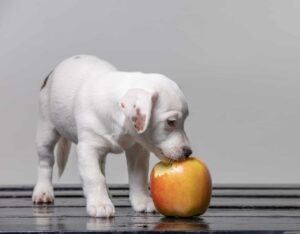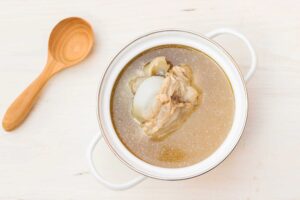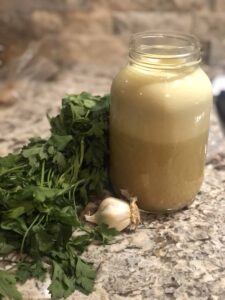Can Dogs Eat Apple Skin? The Secret Benefits of Apples
The skin of apples provides ample fiber, water, and a variety of vitamins like A, C, K, and potassium, which can benefit your dog’s digestion, toxin elimination, immune system, and cellular repair. However, to minimize exposure to pesticides, it’s best to go for organic apples. Remember to shred the peel before feeding it to your dog to prevent choking hazards.
How Can Your Dog Benefit from Eating Apple Skin?
Apple skins contain soluble fibre that is essential for good digestion and elimination of toxins. They also contain vitamins A, C, K and C that support a dog’s vision, skin, immunity, ability to repair cellular damage and reduce inflammation. Fibre in apple peels is also excellent for dogs with diabetes.
Is It Safe for Dogs to Eat Green Apples and Their Skin?
Colour doesn’t matter a whole lot, although there are a few minor differences in their nutritional value:
- Green apples have less sugar and slightly higher amounts of vitamins and minerals, so going green might be a better choice for dogs with diabetes
- Red apples are higher in antioxidants and taste a bit sweeter.
Do Apples Need to Be Organic?
Ideally, yes. If you’re feeding your dog apple peel, stick with organic, non-genetically modified apples to minimize toxins. Wash or soak apples first to remove lingering pesticides and bacteria.
Apples are one of the highest pesticide-laden fruits in the “dirty dozen”. An average of 4.4 different pesticides are present on apple skin. These pesticides are linked to cancer, neurological disease, hormone disruption and diabetes.
How Can I Remove Pesticides from Apple Skin?
To remove most pesticides on apples, soak apples for 15-20 minutes in one of three ways:
- Use a 10% mixture of Himalayan salt water e.g. 1/8 cup salt to 1 1/4 cups water
- Use 1 part vinegar to 4 parts water e.g. 1/2 cups vinegar in 2 cups water
- Mix 1 tsp baking soda in one cup of water
After soaking, rinse with clean water.
Are Genetically Modified Apples Safe?
Genetically modified apples are not considered organic and contain genetic variations to the DNA that allow apples to tolerate more pesticides or take on unnatural characteristics that appeal to marketers looking to sell more apples e.g. delaying the time that an apple starts to turn brown. Studies have shown that genetically modified food such as apples can contribute to kidney, liver, pancreas, digestive and reproductive issues and rapid aging.
Bottom line? Buy organic fruits and vegetables for you and your beautiful Fur Soul.
While apple skin is healthy in itself, don’t stop there! Apples have even more benefits.
Can Dogs Eat Apples?

Yes. Dogs can eat all parts of an apple except for the core, seeds and stem. There are some amazing benefits that most pet parents aren’t aware of.
The Secret Benefits of Apples
Apples and apple peels have some amazing health benefits for your dog:
- Apples have antioxidants, vitamins and minerals to help eliminate toxins and encourage normal cellular repair
- The fibre in apples and apple peel can support healthy digestion and elimination
- Crunching on bite sized apple pieces helps keep teeth clean and breath fresh
- Apples help keep your dog hydrated during the warm weather
- Apples can help with your dog’s environmental allergies
- Apples can help prevent diabetes and support healthier glucose and insulin levels.
Does An Apple a Day Keep the Vet Away?
Maybe… if your dog has seasonal allergies, diabetes or inflammation, apples can play a part in optimizing his health (and that means fewer visits, medication and costs). PS – We love our Holistic and Conventional veterinarians, but we can do a lot in between visits to keep our dogs as healthy as possible.
Adding apples to a whole foods diet may help keep vet bills down and improve your dog’s health, naturally. If your dog has environmental allergies, diabetes or health conditions related to chronic inflammation, here are some ways that apples can help.
Dogs with Seasonal Allergies
If your dog has seasonal or environmental allergies, his body responds by releasing histamine – the substance that makes him sneeze, cough and itch. Medications like Benadryl work by reducing histamine and thus, allergy symptoms.
Apples contain a natural anti-histamine called quercetin that may help his body reduce allergy symptoms by lowering histamine levels. Quercetin is often called “Nature’s Benadryl” for this reason.
For dogs with seasonal or environmental allergies, start with giving him a clean, whole food raw (or lightly cooked) diet. Add foods high in quercetin like diced apples, parsley and blueberries.
Dogs with Diabetes
Most people acknowledge that vegetables are generally preferred over fruits for diabetic dogs due to the higher sugar content in fruit. However, small amounts of apples can actually help your diabetic dog in some surprising ways:
- The fibre in apples slows the absorption of sugar into the blood
- Fibre supports healthy digestion and elimination
- Quercetin in apples can reduce inflammation levels, common in those with diabetes
- Apples are low on the glycemic index, which means they cause a relatively low rise in blood sugar
- Apple skins increase the body’s sensitivity to insulin, which keeps excess glucose out of the blood
- Apples are linked to a reduced risk for developing diabetes
Give your diabetic dogs small portions of organic apples with the peel, in addition to a whole foods diet. Consult with your Holistic Veterinarian, Holistic Canine Nutritionist or Canine Herbalist for the best ways to manage diabetes, naturally.
Dogs with Inflammation
Several health conditions are related to chronic inflammation, such as diabetes, obesity, arthritis and some cancers. Apples contain quercetin whose flavanol molecules are potent anti-inflammatories. Research tells us that the levels of quercetin are higher in organically grown fruits and vegetables, so go for organic wherever possible and support your local organic farmers.
Can Dogs Eat Apple Seeds?
No. The seeds of apples contain a substance that releases cyanide which can affect the amount of oxygen in the body. Although it takes more than one seed (or seeds eaten over a long period of time) to cause significant harm, be safe and don’t let your dog eat whole apples that contain seeds.
Are Apples Bad for a Dog’s Teeth?
No. Although apples do contain sugar, the water content doesn’t allow the sugar to sit on teeth and gums. When your dog eats a whole foods diet including raw meat, vegetables and bones, his saliva becomes more effective at keeping his mouth healthy, and chewing small bits of apples with peel are a natural way to brush his teeth.
Can Dogs Be Allergic to Apples?
Unlikely. Dogs are more likely to be allergic to proteins, such as those found in certain meats or dairy products.
Can Puppies Eat Apples and Apple Skin?

Yes. Apples are a healthy food for puppies. When your puppy’s teeth are growing in though, make sure you dice apples and shred the apple peel first so it doesn’t get stuck in his throat. Once they have a full set of teeth, try letting him chew a small apple slice under constant supervision.
Can Dogs Eat Apple Cores?
No. Apple cores contains seeds that release cyanide and are toxic to dogs. Plus, seeds can become caught in a dog’s throat. Throw your apple cores in the recycling bin.
Can Dogs Eat Apple Sauce?
Avoid giving your dog processed apple sauce with added sugar and preservatives. If your dog has trouble chewing or swallowing raw apples, make homemade apple sauce using organic cored apples that have been gently cooked with water. Mush and mix a little into your dog’s food.
Can Dogs Drink Apple Juice?
Apple juice has concentrated amounts of sugar without the benefits of the fibre contained in fresh apple skin and flesh. This makes juice a poor choice for dogs with diabetes, pancreas or weight problems. Although dogs won’t be harmed by the occasional mouthful of apple juice, stick with the healthier option of apple slices.
How Do I Give an Apple to my Dog?
- Having apple slices for lunch? Feel free to share a bite-sized slice with your Fur Soul
- Have a geriatric dog or a dog that has trouble chewing? Shred the apple and peel to make it easier to swallow. Or, remove the core and skin, and cook apples gently in a bit of water. Mush and mix with food.
- Have a puppy? Dice a bit of apple and shred the peel. Older puppies with a full set of teeth can chew on a small slice of apple under supervision.
How Much Apple Should I Give My Dog?
A slice or two is enough to give your dog. Even too much healthy food can lead to an upset tummy or diarrhea.
For dogs with seasonal allergies, a couple slices a day during allergy season can act as a natural anti-histamine.
Can Dogs Eat Dried Apples?
Dehydrated fruit still has healthy fibre, vitamins and minerals. However by removing water, the amount of sugar in each serving becomes more concentrated. Here are some tips for giving dogs dried apples:
- Give your dog smaller amounts of dried apples than you would fresh apples
- Avoid dried apples for your diabetic dog (opt for fresh)
- Dried apples are a good snack for high energy or working dogs, as they provide a quick energy boost
- Learn how to dehydrate apples yourself to avoid added preservatives, salt and sugar found in most processed dried apple products.
Can Dogs Eat Crab Apples?
It’s probably best to avoid these. Crab apples are a smaller, tarter version of full size apples that are commonly grown in the wild. Unless careful preparation is taken to remove skin, seeds, stems and leaves, dogs can ingest potentially toxic cyanide-releasing substances. If your dog loves the crab apple tree in your yard, consider fencing it off and preparing this treat by removing the peel, seeds, stem and leaves.
What Part of the Apple is Bad for Dogs?
Never give apple cores to your dog. The core contains seeds that release a toxic chemical called cyanide. Cyanide affects the body’s ability to carry oxygen and can be fatal or cause significant injury to people and pets. Apple seeds can also get stuck in a dog’s throat.
While apples are filled with healthy benefits, apples are still one of the dirtiest fruits when it comes to pesticide residue. Apples carry an average of 4-6 different types of pesticides that can contribute to serious illnesses like cancer. To limit exposure to these toxins, choose organic apples and wash off pesticides before giving to your dog.
Dogs are unable to chew apple stems, so stems and leaves should be removed first to prevent choking and damage to the intestines.
Be kind to every living being. Respect the earth we share.
References
https://www.beyondpesticides.org/resources/pesticide-induced-diseases-database/cancer
Shuang Chen, Hongmei Jiang, Xiaosong Wu, Jun Fang, “Therapeutic Effects of Quercetin on Inflammation, Obesity, and Type 2 Diabetes“, Mediators of Inflammation, vol. 2016, Article ID 9340637, 5 pages, 2016. https://doi.org/10.1155/2016/9340637
Yang T, Doherty J, Zhao B, Kinchla AJ, Clark JM, He L. Effectiveness of Commercial and Homemade Washing Agents in Removing Pesticide Residues on and in Apples. J Agric Food Chem. 2017 Nov 8;65(44):9744-9752. doi: 10.1021/acs.jafc.7b03118. Epub 2017 Oct 25. PMID: 29067814.







